The Best Ginkgo Tree Varieties for Garden Planting
Published: November 2, 2025 at 10:11:14 AM UTC
The ginkgo tree (Ginkgo biloba) stands as a living fossil in our modern gardens, having remained virtually unchanged for over 200 million years. With its distinctive fan-shaped leaves that turn a spectacular golden yellow in fall, this ancient tree brings a touch of prehistoric elegance to contemporary landscapes.

Ginkgoes are remarkably resilient, tolerating urban pollution, poor soil, and extreme weather conditions while remaining largely free from pests and diseases. For home gardeners seeking a statement tree with historical significance and year-round visual interest, ginkgo varieties offer exceptional options for nearly any garden setting.
While the standard ginkgo species can grow quite large, numerous cultivated varieties provide options for gardens of all sizes. From towering shade trees to compact dwarf specimens suitable for containers, there's a ginkgo variety to match your space and design preferences. This guide explores seven outstanding ginkgo varieties specifically selected for residential gardens, highlighting their unique characteristics and optimal growing conditions to help you choose the perfect living fossil for your landscape.
1. 'Autumn Gold' - The Classic Golden Beauty
The spectacular golden fall display of Ginkgo 'Autumn Gold'
The 'Autumn Gold' ginkgo lives up to its name with a breathtaking fall display that transforms its canopy into a mass of brilliant saffron-yellow foliage. This male cultivar is among the most popular ginkgo varieties for good reason - it combines the species' legendary hardiness with exceptional ornamental qualities and a manageable size for residential landscapes.
Key Characteristics
- Mature size: 40-50 feet tall, 25-30 feet wide
- Growth rate: Slow when young (about 1 foot per year), moderate once established
- Growth habit: Conical when young, developing a symmetrical, broadly spreading crown with age
- Seasonal interest: Medium green leaves in summer, uniform golden-yellow fall color
- Hardiness zones: 4-9
- Gender: Male (fruitless, no messy or smelly fruit)
What makes 'Autumn Gold' particularly special is its uniformity of fall color and the dramatic way its leaves drop. Unlike many deciduous trees that lose their leaves gradually, ginkgoes often drop their entire golden canopy within a short period, creating a stunning golden carpet beneath the tree. This male cultivar was introduced by the Saratoga Horticultural Foundation in California around 1955 and has been a landscape favorite ever since.
Perfect for larger residential yards, 'Autumn Gold' makes an excellent specimen or shade tree. Its symmetrical branching structure provides visual interest even in winter, while its resistance to urban pollution makes it suitable for city gardens. The tree's moderate size at maturity means it won't overwhelm most residential properties.
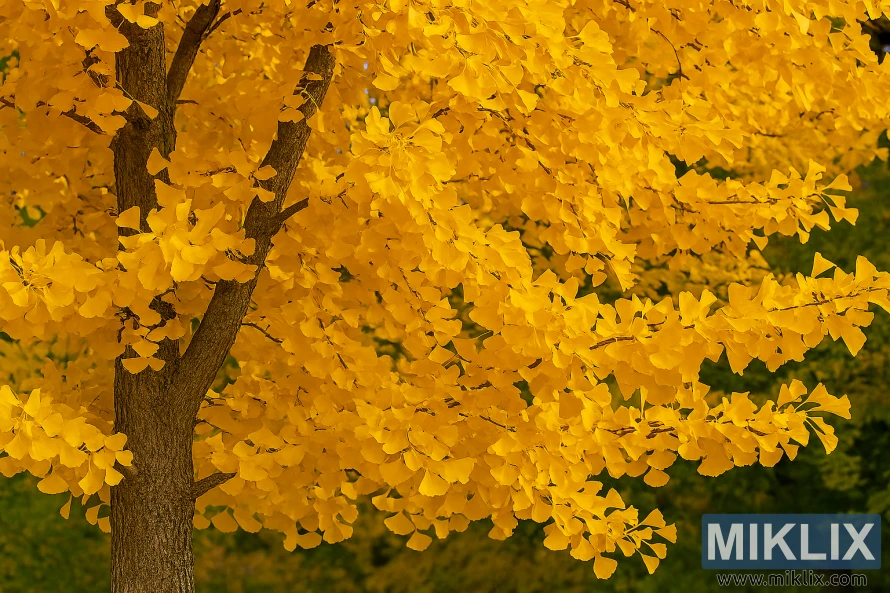
2. 'Princeton Sentry' - Elegant Columnar Form
'Princeton Sentry' ginkgo's distinctive narrow, upright form
For gardens with limited horizontal space, 'Princeton Sentry' offers the perfect solution. This male cultivar features a distinctly columnar growth habit that brings vertical interest to the landscape while requiring minimal ground space. Its slender profile makes it ideal for narrow side yards, property boundaries, or as a striking accent in formal garden designs.
Key Characteristics
- Mature size: 40-60 feet tall, 15-25 feet wide
- Growth rate: Slow to moderate (8-12 inches per year)
- Growth habit: Narrowly columnar with upright branches
- Seasonal interest: Bright green summer foliage, golden-yellow fall color
- Hardiness zones: 4-8
- Gender: Male (fruitless)
'Princeton Sentry' was selected and introduced by Princeton Nursery for its exceptional upright form. The branches grow at sharp upward angles, creating a distinctly vertical silhouette that maintains its narrow shape without pruning. Like other ginkgoes, it displays remarkable tolerance for urban conditions, including air pollution, compacted soil, and drought once established.
This variety works beautifully as a specimen tree, in formal allées, or as a living screen when planted in a row. Its architectural form provides strong vertical lines in the landscape, making it particularly effective in contemporary garden designs. The golden fall color is just as spectacular as other ginkgo varieties, creating a stunning vertical column of yellow that stands out dramatically in autumn landscapes.
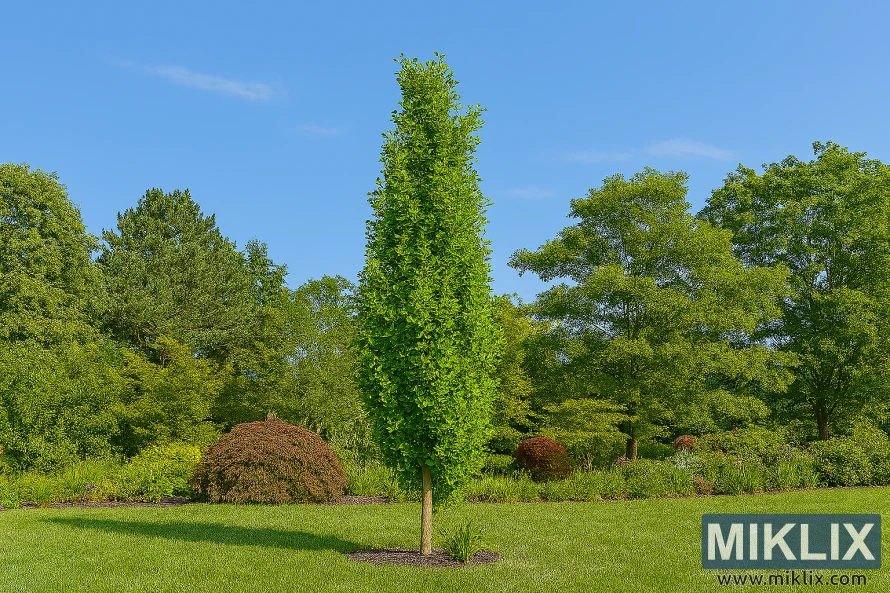
3. 'Mariken' - Compact Dwarf for Small Gardens
The compact, globe-shaped form of 'Mariken' dwarf ginkgo
Not all ginkgoes need to be towering specimens. The charming 'Mariken' cultivar brings the ancient elegance of ginkgo to small gardens, patios, and even container plantings. This dwarf variety forms a dense, rounded shape that grows very slowly, making it perfect for spaces where a full-sized tree would be overwhelming.
Key Characteristics
- Mature size: 2-3 feet tall and wide after 10 years; eventually reaching 4-5 feet
- Growth rate: Very slow (2-4 inches per year)
- Growth habit: Dense, compact globe with short internodes
- Seasonal interest: Bright green summer foliage, golden-yellow fall color
- Hardiness zones: 4-9
- Gender: Male (fruitless)
'Mariken' was discovered as a chance seedling in the Netherlands and has become highly prized for its exceptional dwarf characteristics. The leaves are slightly smaller than the species but maintain the distinctive fan shape that makes ginkgoes so recognizable. Despite its diminutive size, 'Mariken' displays the same spectacular fall color as its larger relatives.
This versatile dwarf ginkgo excels in rock gardens, mixed borders, or as a specimen in small urban gardens. It's particularly well-suited for container growing, where its slow growth rate means it can remain in the same pot for many years. 'Mariken' can also be grown as a bonsai specimen, bringing the ancient character of ginkgo to an even smaller scale.
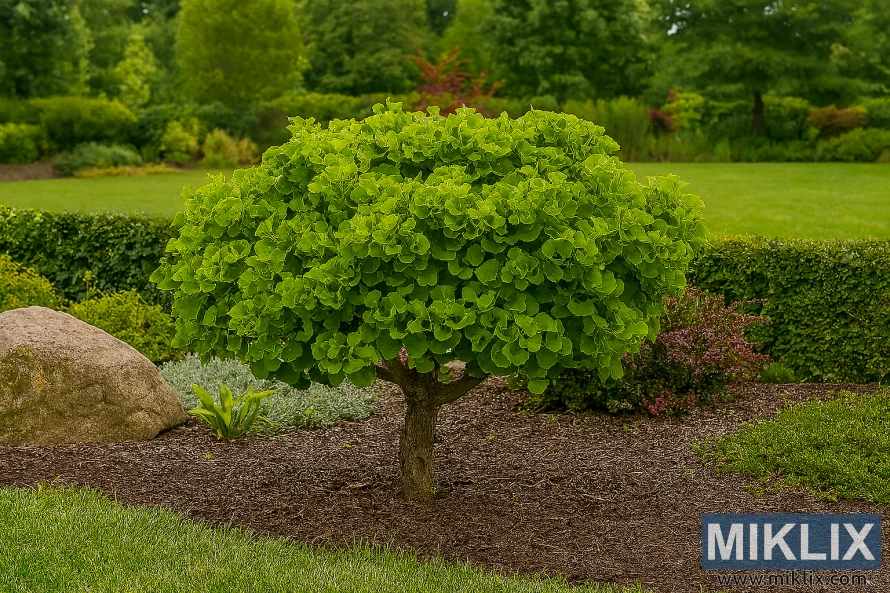
4. 'Jade Butterfly' - Distinctive Leaf Form
The distinctive butterfly-like leaves of 'Jade Butterfly' ginkgo
'Jade Butterfly' stands out among ginkgo varieties for its uniquely shaped leaves. While all ginkgo leaves have the characteristic fan shape, this cultivar's foliage is deeply notched, creating two distinct lobes that resemble butterfly wings. This distinctive leaf structure, combined with a manageable size, makes 'Jade Butterfly' a standout choice for collectors and those seeking something truly special.
Key Characteristics
- Mature size: 12-15 feet tall, 6-10 feet wide
- Growth rate: Slow to moderate
- Growth habit: Upright, vase-shaped form
- Seasonal interest: Distinctive jade-green summer foliage with deep notching, bright yellow fall color
- Hardiness zones: 4-9
- Gender: Male (fruitless)
The pale jade-green color of the summer foliage gives this variety part of its name, while the deeply divided leaves that resemble butterfly wings provide the other half. The leaves are arranged densely along the branches, creating a full, lush appearance despite the tree's relatively small stature.
'Jade Butterfly' works beautifully as a specimen tree in smaller landscapes or as part of a mixed border where its unique foliage can be appreciated up close. Its moderate size makes it suitable for urban gardens and suburban yards alike. Like all ginkgoes, it's remarkably adaptable to different soil conditions and resistant to pests and diseases.
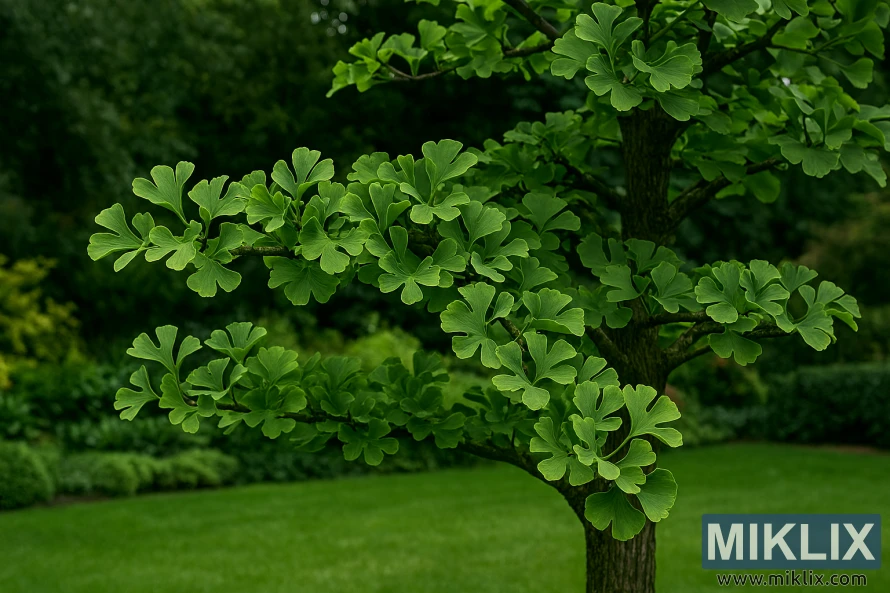
5. 'Troll' - Ultra-Dwarf for Rock Gardens
The ultra-compact 'Troll' ginkgo in a rock garden setting
For the smallest garden spaces or for creating miniature landscapes, 'Troll' ginkgo offers an ultra-dwarf option that packs all the character of its larger relatives into a tiny package. This diminutive cultivar grows at an extremely slow rate, forming a dense, somewhat irregular mound that adds character to rock gardens, troughs, or container plantings.
Key Characteristics
- Mature size: 1-2 feet tall and wide after 10 years; eventually reaching 2-3 feet
- Growth rate: Extremely slow (1-2 inches per year)
- Growth habit: Dense, irregular mound with gnarly branching
- Seasonal interest: Small fan-shaped green leaves, golden-yellow fall color
- Hardiness zones: 4-8
- Gender: Male (fruitless)
'Troll' was discovered as a witch's broom (a dense growth caused by a genetic mutation) on another ginkgo tree. Its extremely compact form and twisted branching give it a character that lives up to its name. Despite its small size, it displays the same golden fall color that makes ginkgoes so prized for autumn interest.
This ultra-dwarf variety is perfect for rock gardens, alpine troughs, bonsai culture, or as a specimen in very small spaces. Its slow growth rate means it will stay in scale with miniature garden designs for many years without requiring frequent pruning. 'Troll' also works well in mixed container plantings where its distinctive form adds architectural interest.
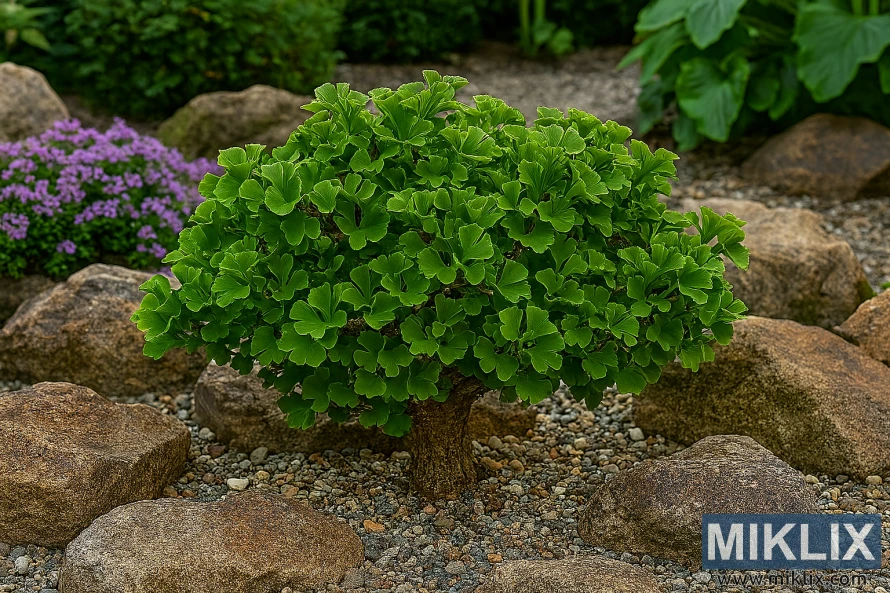
6. 'Shangri-La' - Fast-Growing Pyramidal Form
The balanced, pyramidal form of 'Shangri-La' ginkgo
For gardeners seeking a ginkgo that establishes more quickly than most varieties, 'Shangri-La' offers a solution. This cultivar grows at a faster rate than many other ginkgoes while maintaining an attractive, pyramidal form with a balanced crown. Its relatively rapid development makes it an excellent choice for gardeners who don't want to wait decades to enjoy a mature specimen.
Key Characteristics
- Mature size: 40-55 feet tall, 30-40 feet wide
- Growth rate: Moderate to fast for a ginkgo (12-18 inches per year once established)
- Growth habit: Pyramidal with a balanced, rounded crown at maturity
- Seasonal interest: Dense green summer foliage, golden-yellow fall color
- Hardiness zones: 4-9
- Gender: Male (fruitless)
Patented in 1984, 'Shangri-La' was selected for its vigorous growth rate and well-formed crown. The branches develop with good symmetry, creating a balanced silhouette that requires little corrective pruning. Like other ginkgoes, it's remarkably resistant to pests and diseases, making it a low-maintenance choice for long-term landscape plantings.
This variety works well as a shade tree, specimen, or as part of a larger landscape design. Its moderate growth rate makes it suitable for establishing new gardens where more immediate impact is desired. 'Shangri-La' also displays excellent resistance to urban conditions, including air pollution and compacted soils.
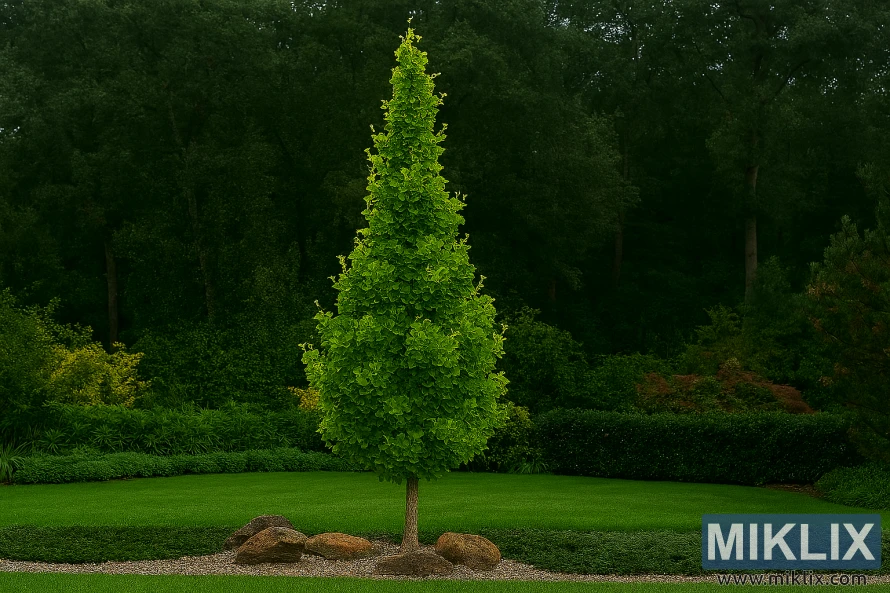
7. 'Saratoga' - Distinctive Leaf Shape
The distinctive narrow, fishtail-shaped leaves of 'Saratoga' ginkgo
'Saratoga' offers a fascinating variation on the classic ginkgo leaf shape. While maintaining the recognizable fan structure, its leaves are narrower and more elongated, resembling a fishtail. This distinctive foliage, combined with a moderate size and symmetrical growth habit, makes 'Saratoga' a standout choice for collectors and those seeking something different from standard ginkgo varieties.
Key Characteristics
- Mature size: 35-40 feet tall, 25-30 feet wide
- Growth rate: Slow to moderate
- Growth habit: Symmetrical, broad-spreading crown
- Seasonal interest: Distinctive narrow, fishtail-shaped green leaves; golden-yellow fall color
- Hardiness zones: 4-9
- Gender: Male (fruitless)
Introduced by the Saratoga Horticultural Foundation in 1975, this cultivar was selected for its unique leaf shape and well-formed growth habit. The narrower leaves give the tree a slightly more delicate appearance than other ginkgo varieties, though it maintains the same legendary toughness and adaptability.
'Saratoga' makes an excellent specimen tree where its distinctive foliage can be appreciated. Its moderate size at maturity makes it suitable for average residential landscapes, while its symmetrical branching creates an attractive silhouette even in winter. Like all ginkgoes, it's remarkably free from pest and disease problems.

Ginkgo Variety Comparison Guide
To help you select the perfect ginkgo variety for your garden, we've compiled this quick-reference comparison table highlighting the key characteristics of our recommended cultivars:
| Variety | Mature Height | Mature Width | Growth Rate | Growth Habit | Special Features | Best Uses |
| 'Autumn Gold' | 40-50 feet | 25-30 feet | Slow to moderate | Broadly spreading | Uniform golden fall color | Shade tree, specimen |
| 'Princeton Sentry' | 40-60 feet | 15-25 feet | Slow to moderate | Narrowly columnar | Upright, narrow form | Narrow spaces, screening |
| 'Mariken' | 4-5 feet | 4-5 feet | Very slow | Dense globe | Compact dwarf form | Small gardens, containers |
| 'Jade Butterfly' | 12-15 feet | 6-10 feet | Slow to moderate | Upright, vase-shaped | Deeply notched leaves | Specimen, mixed borders |
| 'Troll' | 2-3 feet | 2-3 feet | Extremely slow | Irregular mound | Ultra-dwarf size | Rock gardens, containers |
| 'Shangri-La' | 40-55 feet | 30-40 feet | Moderate to fast | Pyramidal | Faster growth rate | Shade tree, specimen |
| 'Saratoga' | 35-40 feet | 25-30 feet | Slow to moderate | Symmetrical, spreading | Narrow, fishtail-shaped leaves | Specimen, shade tree |
Planting and Care Guidelines for Ginkgo Trees
Proper planting technique for young ginkgo trees
Ginkgo trees are remarkably adaptable and low-maintenance once established, but proper planting and initial care are crucial for their long-term success. Follow these guidelines to give your ginkgo the best possible start in your garden.

Soil Requirements and Sunlight Needs
- Soil: Ginkgoes adapt to almost any soil type, from clay to sand, as long as it's not permanently wet. They prefer well-drained soil but tolerate poor urban soils remarkably well.
- pH: Adaptable to a wide range of soil pH levels from slightly acidic to slightly alkaline (5.5-8.0).
- Sunlight: Plant in full sun for best growth and fall color. Ginkgoes will tolerate partial shade but may grow more slowly and develop less vibrant autumn color.
- Exposure: Highly tolerant of urban conditions, including pollution, salt, heat, and compacted soil.
Planting Instructions and Spacing
- Timing: Plant in spring or fall when temperatures are moderate.
- Hole preparation: Dig a hole 2-3 times wider than the root ball but no deeper than the root ball's height.
- Placement: Position the tree so the root flare (where the trunk widens at the base) is slightly above soil level.
- Backfilling: Use the same soil removed from the hole without amendments. Firm gently but don't compact.
- Spacing: For standard varieties, plant at least 15-25 feet from buildings and other large trees. Dwarf varieties can be placed 5-10 feet apart, depending on their mature size.
Watering and Fertilization
- Initial watering: Water thoroughly at planting, ensuring the entire root ball and surrounding soil are moistened.
- Establishment period: Water deeply once a week during the first growing season, providing about 1-2 gallons per inch of trunk diameter.
- Established trees: Once established (usually after 2-3 years), ginkgoes are quite drought-tolerant and rarely need supplemental watering except during extended dry periods.
- Fertilization: Ginkgoes generally don't require regular fertilization. If growth seems slow, apply a balanced slow-release fertilizer in early spring.
Pruning Techniques and Timing
- Young trees: Minimal pruning is needed. Remove only damaged, diseased, or crossing branches.
- Timing: If pruning is necessary, do it in late winter or early spring before new growth begins.
- Branch structure: Ginkgoes naturally develop an attractive branching pattern. Avoid heavy pruning that would disrupt their natural form.
- Dwarf varieties: These may occasionally need light shaping to maintain their compact form, but extensive pruning is rarely necessary.
Common Pests and Diseases
One of the greatest advantages of ginkgo trees is their remarkable resistance to pests and diseases. They are rarely troubled by the issues that affect many other landscape trees, making them exceptionally low-maintenance choices for the garden.
Ginkgo Strengths
- Virtually immune to most insect pests
- Highly resistant to diseases
- Tolerant of urban pollution
- Adaptable to poor soils
- Resistant to storm damage
Potential Concerns
- Slow initial growth (first 3-5 years)
- Possible leaf scorch in very hot, dry conditions
- Female trees produce messy, malodorous fruit (all recommended varieties are male)
- May develop chlorosis (yellowing) in highly alkaline soils
Design Ideas for Incorporating Ginkgo Trees in Your Garden
A ginkgo tree as a focal point in a Japanese-inspired garden
The distinctive form and ancient lineage of ginkgo trees make them versatile additions to various garden styles. Here are some design ideas for incorporating these living fossils into your landscape:
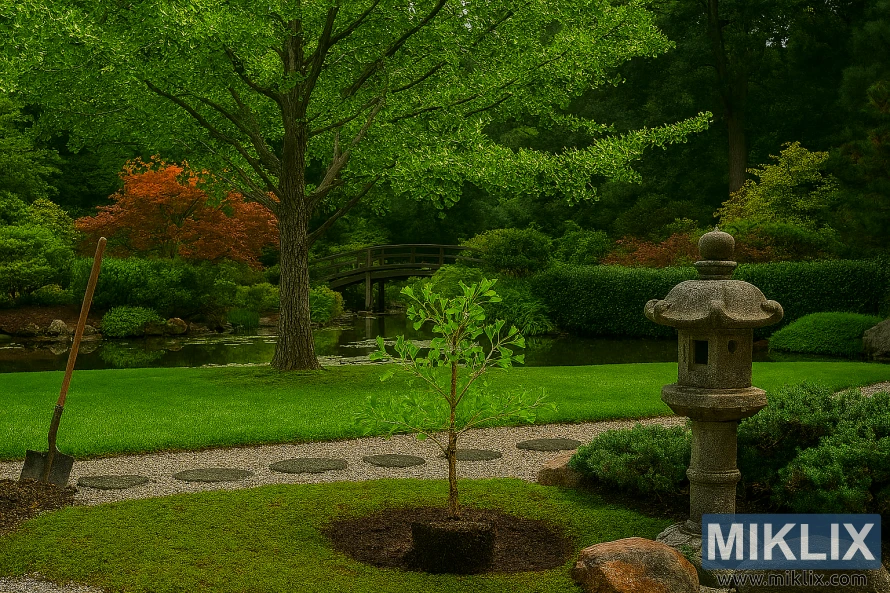
Japanese and Asian-Inspired Gardens
Given the ginkgo's sacred status in Buddhist and Confucian traditions, these trees are natural choices for Japanese and Asian-inspired gardens. Their elegant form and golden fall color complement traditional elements like stone lanterns, water features, and carefully placed rocks. Consider using:
- 'Princeton Sentry' as a vertical accent near a garden entrance
- 'Mariken' or 'Troll' as bonsai specimens or container plants on a patio
- 'Autumn Gold' as a focal point tree, underplanted with Japanese forest grass (Hakonechloa) and hostas
Modern Landscapes
The clean lines and distinctive leaf shape of ginkgo trees work beautifully in contemporary garden designs. Their architectural form provides structure and visual interest throughout the seasons. Consider:
- A row of 'Princeton Sentry' to create a living screen with strong vertical lines
- 'Jade Butterfly' as a specimen tree in a minimalist garden with gravel mulch and architectural perennials
- 'Shangri-La' as a shade tree over a modern patio or seating area
Traditional and Cottage Gardens
Despite their exotic origins, ginkgo trees blend surprisingly well with traditional garden styles. Their golden fall color complements late-season perennials and grasses. Consider:
- 'Autumn Gold' as a specimen tree in a lawn, surrounded by a circle of spring bulbs
- 'Saratoga' as a shade tree near a seating area, underplanted with shade-tolerant perennials
- 'Mariken' in a mixed border with perennials and flowering shrubs
Small Space Solutions
Even the smallest gardens can accommodate a ginkgo with the right variety selection. Consider:
- 'Troll' in a rock garden or alpine trough
- 'Mariken' in a decorative container on a patio or balcony
- 'Jade Butterfly' as a focal point in a courtyard garden
- 'Princeton Sentry' for narrow side yards or property boundaries
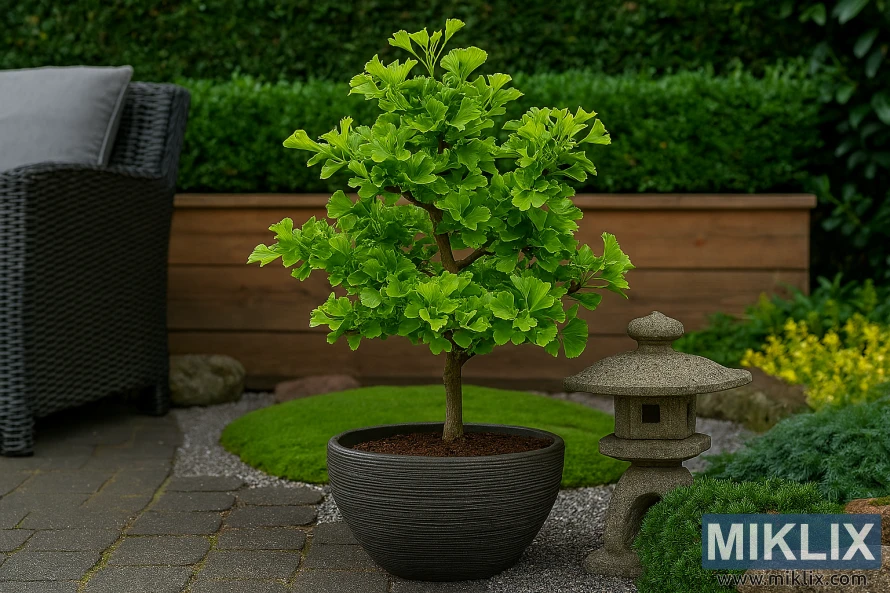
Conclusion: A Living Fossil for the Modern Garden
Ginkgo trees offer a remarkable combination of historical significance, ornamental beauty, and practical benefits for today's gardens. As living fossils that have remained virtually unchanged for millions of years, they bring a sense of permanence and connection to the distant past. Their distinctive fan-shaped leaves, spectacular fall color, and architectural winter silhouettes provide year-round interest in the landscape.
With the diverse range of cultivars now available, there's a ginkgo variety suitable for nearly any garden situation, from spacious suburban yards to tiny urban patios. Their legendary adaptability to different growing conditions and remarkable resistance to pests and diseases make them low-maintenance choices that will thrive for generations.
Whether you choose the classic golden splendor of 'Autumn Gold,' the space-saving columnar form of 'Princeton Sentry,' or one of the charming dwarf varieties like 'Mariken' or 'Troll,' a ginkgo tree is more than just a plant—it's a living piece of Earth's history and a legacy for future generations to enjoy.
Further Reading
If you enjoyed this post, you may also like these suggestions:
- The Best Maple Trees to Plant in Your Garden: A Guide to Species Selection
- Best Oak Trees for Gardens: Finding Your Perfect Match
- The Best Linden Tree Varieties to Plant in Your Garden
